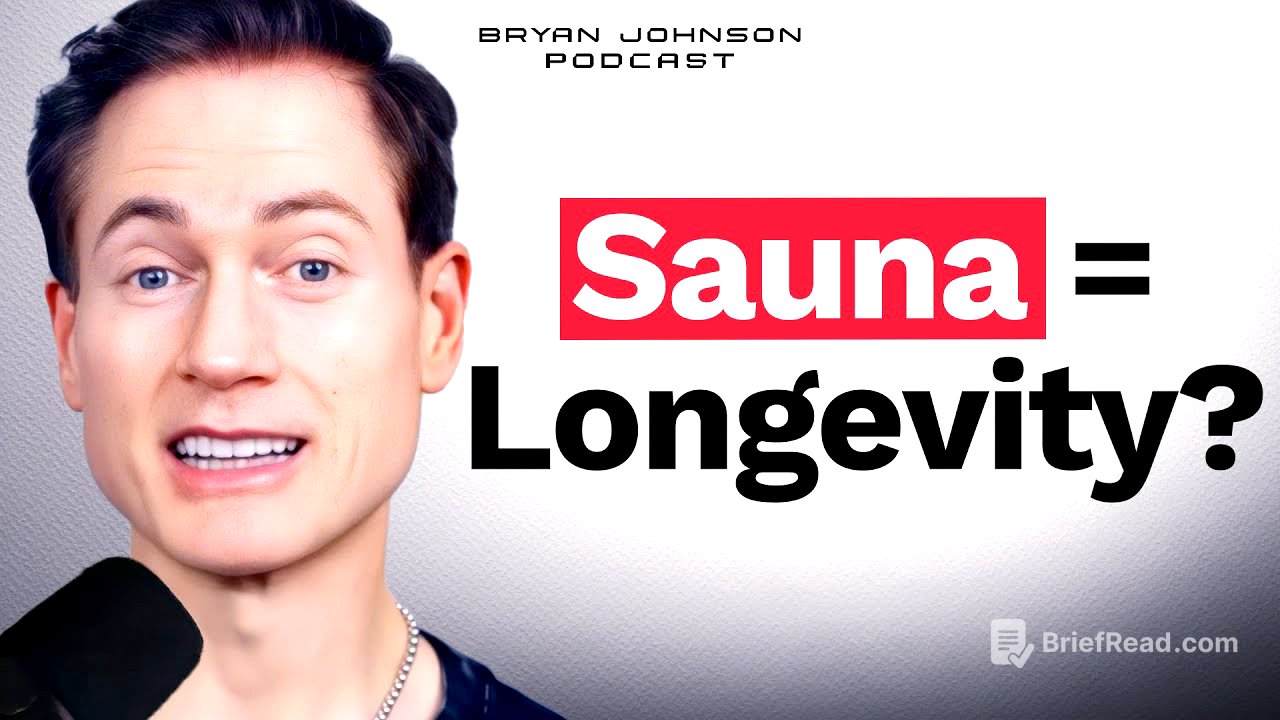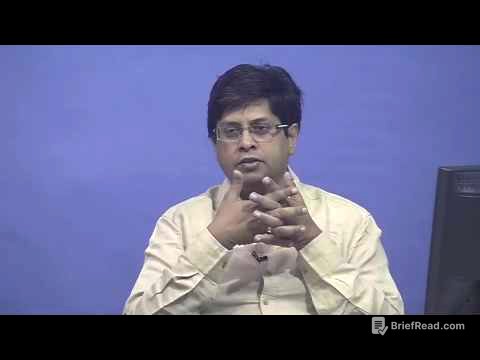TLDR;
This podcast episode explores the science and practical application of sauna use for longevity and health. Bryan Johnson, along with Kate and Mike, discuss the benefits of sauna, including cardiovascular health improvements, heat shock protein activation, and potential toxin removal. They also cover the specifics of Bryan's new sauna protocol, challenges he faced, and tips for safe and effective sauna use. The conversation touches on unexpected benefits, such as improvements in vascular health and potential impacts on the microbiome and brain function.
- Sauna use can lead to significant reductions in cardiovascular disease, dementia, and overall mortality.
- The heat from sauna mimics exercise by increasing heart rate and dilating blood vessels.
- Heat shock proteins are activated by sauna, aiding in protein refolding and overall cellular health.
First Impressions of Sauna [0:00]
Bryan introduces the topic of sauna and its potential health benefits. He mentions inviting Kate to join him in a sauna session to compare experiences, as he found the initial sessions quite challenging. Kate shares her initial apprehension about the high temperature (200°F) but found the experience comfortable and soothing, contrasting with Bryan's more intense reaction. Bryan notes that having Kate present helped distract him during the 20-minute session.
Assessing the Sweat Response in Kate and Bryan [1:30]
The discussion centres on assessing sweat capacity during sauna use. Bryan and Kate used a patch to measure sweat rate and salt content. Kate barely broke a sweat in the 200°F sauna, while Bryan sweated significantly. It was initially thought there might be something wrong with Kate, but Bryan later realised his higher sweat rate was due to working out beforehand. He corrected for this in a subsequent session, achieving a sweat profile similar to Kate's when entering the sauna without prior exercise.
Why Sauna? The Science Behind the Heat [3:00]
The podcast explores the scientific reasons behind sauna's health benefits. Mike highlights that sauna is associated with a 50-70% reduction in cardiovascular disease and a 40% reduction in overall mortality, based on studies primarily from Finland. These benefits require relatively low effort, involving sitting in a warm environment for 20 minutes, four to seven times a week. Bryan acknowledges that sauna is one of the easiest entry points for health, contrasting it with more strenuous activities like high-intensity workouts.
How Sauna Mimics Exercise [5:20]
Mike explains the mechanisms through which sauna provides health benefits, noting that while sweating aids in detoxification, the primary mechanism is the heat itself. The heat increases nitric oxide production, dilating blood vessels and providing a workout for the vascular system, which helps reduce blood pressure. Sauna also increases heart rate, mimicking zone one or two exercise. Additionally, it activates heat shock proteins, which help refold misfolded proteins and improve overall protein function, similar to the body's response during a fever.
Early Biomarker Changes with Sauna [8:30]
The discussion continues on the effects of sauna on hormone levels, noting increases in growth hormone and reductions in cortisol and inflammation (CRP). Bryan mentions that heat shock proteins 70 and 72 can increase significantly within 30 to 60 minutes of sauna use. Mike expresses doubt that significant changes in Bryan's blood markers would be seen after only 18 sessions, given his already optimised health. However, Bryan notes improved blood flow during a recent blood draw, potentially linked to sauna-induced vascular changes.
Protocol Design & Measurement Strategy [12:00]
Bryan explains the new longevity protocol focused on sauna, following the completion of hyperbaric oxygen therapy (HBOT). He highlights that the evidence supporting sauna is compelling, despite limitations in being primarily observational rather than interventional. The protocol includes comprehensive baseline measurements, such as a full blood panel, vascular health markers (SDMA, ADMA, F2), and central blood pressure monitoring. Early measurements after seven sessions showed significant improvements in central blood pressure and pulse pressure.
Bryan’s Difficulties Starting the Sauna Protocol [15:30]
Bryan shares his initial difficulties with the sauna protocol, particularly the exhaustion and sleep disruption experienced in the first two weeks. This was attributed to the combination of intense workouts followed immediately by 200°F sauna sessions. He also mentions using ice packs to maintain sperm health and prevent scalp irritation. Mike apologises for the intensity of the initial protocol, suggesting a more gradual approach could have been taken.
Why Bryan Ices His Testicles in the Sauna [18:00]
Bryan elaborates on his sauna protocol, which involves daily 20-minute sessions. He explains that he uses ice packs on his testicles and head to mitigate potential negative effects of the heat on sperm health and to prevent scalp irritation. The use of ice packs ensures that he can maintain fertility health while undergoing the sauna sessions.
Electrolyte Loss & Cramping [21:00]
Bryan discusses his experience with severe cramping due to electrolyte imbalance during the initial days of the sauna protocol. He explains that he wasn't replenishing enough electrolytes, specifically sodium, potassium, and magnesium. After measuring his sweat rate and sodium content using a Gatorade patch, he adjusted his electrolyte intake to match his losses, which resolved the cramping issue.
Dry vs. Wet Sauna [24:30]
The podcast addresses the differences between dry and wet saunas. A dry sauna maintains 10-20% relative humidity, while a wet sauna approaches 100% humidity. The Finnish sauna typically operates between 176°F and 212°F with low humidity. The consensus is that dry saunas have more robust evidence supporting their therapeutic benefits compared to wet saunas.
Practical Home Sauna Protocol [27:00]
Bryan and Mike summarise a practical home sauna protocol: using a dry sauna at 200°F (93°C) for 20 minutes daily, wearing ice packs on the head and testicles, and rehydrating with electrolytes immediately afterwards. Bryan drinks 40 ounces of water, split before and after the session, with electrolytes. Mike suggests that individuals can replicate this protocol, adjusting salt intake based on their sweat rate and ensuring adequate water intake.
Groups Who Shouldn’t Use Sauna [30:00]
Mike outlines groups who should exercise caution with sauna use, including pregnant women, individuals with unmanaged cardiovascular disease, and those with electrolyte imbalance issues like POTS syndrome. He advises starting slowly and easing into sauna use to assess tolerance. He also suggests that warm baths or exercise can provide similar benefits for those without access to a sauna.
Unexpected Effects of Sauna and Areas to Explore [33:00]
Kate shares that sauna use significantly improves her HRV. The group discusses how sauna seems to address vascular health in a way that nutrition, supplementation, and exercise alone have not. Mike suggests exercise as the next best alternative to sauna for activating heat shock proteins and increasing core body temperature. Bryan expresses excitement about potential unexpected findings from the sauna protocol, such as changes in the microbiome or PAL levels (a marker for Alzheimer's).
Skin Exposure & Sauna Material Safety [38:00]
The discussion shifts to the importance of minimising skin exposure to potentially harmful chemicals during sauna use. Kate suggests that Bryan should consider being nude in the sauna to avoid exposure to glyphosate and other chemicals that may be present in clothing. They also emphasise the importance of ensuring that the sauna itself is made from safe materials and has good air quality, free from harmful fumes from woods and glues.
Sauna Hygiene & Post-Sweat Protocol [42:30]
Mike recommends showering immediately after sauna use to remove toxins and chemicals excreted in sweat, preventing their reabsorption. Bryan mentions wiping off sweat during the sauna session, though Mike isn't sure if this is necessary. The group also discusses the importance of using clean water (such as reverse osmosis filtered water) if pouring water on the sauna rocks to avoid inhaling contaminants.
Measuring Sweat Toxins [45:00]
Bryan expresses interest in finding a company that can test sweat for toxins to assess daily excretion levels. The group brainstorms ways to collect sweat samples and suggests potentially sending them to a urine testing company. They acknowledge the challenge of collecting a sufficient volume of sweat and the potential for the sample to be flagged as non-urine due to the lack of creatinine.
Kate and Bryan’s Personal Sauna Habits [47:30]
Mike shares that he uses a sauna in his garage two to three times a week, aiming for four or more. Kate does not currently have a sauna routine but is considering getting one, pending Bryan's results. She enjoys the experience of being in the sauna and loves the heat.
Sun Damage and Skin Aging with Teens [49:00]
Kate discusses the high UV levels in Australia and the common practice of spending time in the sun without protection. She mentions her sister's significant UV damage, as revealed by a skin age test. Mike shares his experience with the skin age test, noting that his left side showed more sun damage from driving. He also talks about his struggle to convince his 15-year-old daughter to protect her skin from the sun, highlighting the cultural pressure to be tan and the difficulty of conveying the long-term consequences of sun exposure to teenagers.
Protocol as Part of a Broader Mission [54:00]
Bryan concludes by emphasising that his longevity efforts are part of a broader mission to turn away from death and find new ways of meaning for the human race. He hopes to inspire others to think about their health and well-being in a larger context, beyond just daily routines.









